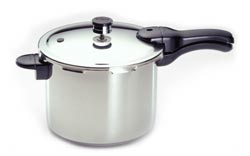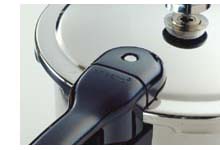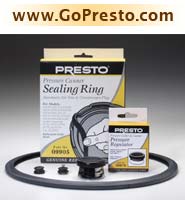If you plan to purchase a pressure cooker for the first time, or if you are considering upgrading to a newer model, you'll be faced with a variety of choices when you begin shopping for a pressure cooker. To help with your decision, we've prepared this buyer's guide so you’ll be able to determine the model that is best suited to your needs.
What is the difference between aluminum and stainless steel pressure
cookers?

Aluminum pressure cookers are lightweight, low cost, and provide uniform heating
performance due to the excellent heat conduction of aluminum. With heavy use,
however, aluminum cookware will stain and pit and, although this doesn’t
affect how it cooks, it’s important to note aluminum’s intrinsic
weakness. Economy is the main reason to choose an aluminum pressure cooker.
Stainless steel pressure cookers are nonporous, slightly heavier, and more expensive
than aluminum models. The extremely durable nature of stainless steel will provide
years of use with a beautiful high luster finish. However, by itself, stainless
steel is not a good conductor of heat, so it’s best to select a model with
a layered base, usually a disc of aluminum bonded to the outside bottom of the
pan. This will greatly improve the heating characteristics and performance of
a stainless steel pressure cooker by eliminating “hot spots” that
would otherwise be common in stainless steel cookware.
What size pressure cooker is best?
Most pressure cookers are sold by the size of their total liquid capacity even
though the actual usable capacity of a pressure cooker is one half to two thirds
of its liquid capacity, depending upon the food being cooked. The extra space
left in the cooker is necessary to allow steam to build inside the unit. Although,
there are many sizes of pressure cookers in the marketplace, the most popular
sizes are 4-, 6-, and 8-quart liquid capacities. We’ll explore the advantages
of these popular sizes to help you determine the best size for your needs.
4-quart: A good size for singles or couples or for making one
course for a family, such as potatoes or vegetables. Whole meal recipes for one
or two people can usually be accommodated in a 4-quart pressure cooker.
6-quart: The most popular size for many families of two or more.
It can accommodate most foods and most pressure cooking recipes are developed
for a 6-quart pressure cooker.
8-quart: This size is good for larger families and is also an
excellent capacity for making large batches of stock.
NOTE: Large-size pressure cooker/canners (16-, 18-, and 23-quart models, for
example) are also available and used generally for pressure canning meats, vegetables,
and other low-acid foods in pint and quart jars. For pressure cooking use, these
large size canners are usually suitable only if you are cooking for a very large
group.
What is the best brand of pressure cooker?
Over the course of time, many different companies have manufactured pressure
cookers. Because the pressure cooker you purchase today should be expected to
provide many years of service, it is important to select a brand that will allow
you to get the most from your investment. Therefore, the following guidelines
should be considered when making your selection.
Choose a brand from a company that has been in business for a number of
years and has a stable financial track record. To keep your pressure cooker
operating properly and safely for many years, you will have to periodically
replace a few inexpensive parts (just as you would replace spark plugs
and fan belts on your car). You need to be confident that the brand you
purchase today will be from a company that will be in business for years
to come in order to assure a supply of the proper parts. Parts are not
interchangeable from one brand to another, so don't select a "brand
X " model simply because it is less expensive.
Buy a brand handled by a reputable retailer. This could be a local store
of a national chain, a department store, a well-established kitchen store,
your local hardware dealer, or a respectable web retailer. You may want
to select a retailer that also stocks the replacement parts you will eventually
need.
Select a brand that has been listed or approved by an independent testing
organization. This will ensure that your pressure cooker meets or exceeds
certain quality and performance standards that have been independently verified.
Underwriters Laboratories (UL) is the testing organization familiar to most
Americans.
Which pressure cooker features should you look for?
NOTE: If you have not done so already, it is best to review the How
To Select The Right Model For Your Needs section to determine the type and
size of pressure cooker you want before studying these specific features. If
you are not familiar with pressure cooking, you may also want to check out the How
To Use section which provides a detailed explanation of how a pressure cooker
works.
 PRESSURE
REGULATOR: Every pressure cooker must have a means of indicating and
controlling the cooking pressure inside the pot. Over the years, many types of
pressure regulators have been designed to perform this function. There are basically
three styles of pressure regulators. They are all somewhat different from each
other, but will, ultimately, provide the same results with your recipe. The first
is a weighted valve pressure regulator (sometimes called a jiggle top), the second
is a modified weighted valve pressure regulator, and the third is a spring valve
pressure regulator. Regardless of which one you choose, always select a regulator
with a maximum operating pressure of 15 psi (pounds per square inch). This is
the standard pressure used in pressure cooking. Virtually all recipes are written
for a pressure of 15 psi and if the operating pressure on your cooker is lower
than 15 pounds, you will not realize the maximum time savings.
PRESSURE
REGULATOR: Every pressure cooker must have a means of indicating and
controlling the cooking pressure inside the pot. Over the years, many types of
pressure regulators have been designed to perform this function. There are basically
three styles of pressure regulators. They are all somewhat different from each
other, but will, ultimately, provide the same results with your recipe. The first
is a weighted valve pressure regulator (sometimes called a jiggle top), the second
is a modified weighted valve pressure regulator, and the third is a spring valve
pressure regulator. Regardless of which one you choose, always select a regulator
with a maximum operating pressure of 15 psi (pounds per square inch). This is
the standard pressure used in pressure cooking. Virtually all recipes are written
for a pressure of 15 psi and if the operating pressure on your cooker is lower
than 15 pounds, you will not realize the maximum time savings.
Weighted Valve: The weighted valve pressure regulator
is placed on top of the vent pipe, which is a small opening in the cover of the
pressure
cooker designed to allow excess steam to escape during cooking. Always
select a pressure cooker that has a removable pressure regulator. This
is important because you will want to examine the vent pipe before each
use to be sure it is clear, and clean it if necessary. Weighted valve
pressure cookers regulate the pressure inside the unit with a rocking motion.
When
you hear and see the pressure regulator begin to rock, the cooking time
begins. Adjust your heat setting to a lower temperature to maintain
a slow, gentle rock. This type of regulator will automatically release steam
from
the cooker in order to maintain 15 psi (pounds per square inch), the
pressure needed on most pressure cooking recipes. Maintaining a slow and gentle
rock, however, is important because it keeps the steam release to a
minimum.
The rocking motion also provides a continuous audible and visual indicator
that the pressure cooker is operating properly and maintaining the proper
cooking pressure. If your cooker becomes completely quiet, you will
know -- before
it’s too late -- that your recipe needs attention. Pressure cookers
with this type of regulator are modestly priced.
Modified Weighted Valve: The modified weighted valve pressure regulator
is attached to the cooker. It does not rock, but, instead, intermittently
releases steam in short bursts letting steam escape when needed to maintain
15 psi. Cooking time begins when steam begins to escape from the regulator.
It is sometimes difficult to tell when steam begins to escape, so you
must watch carefully. You will need to adjust your heat setting to a
lower temperature
to maintain a slow release of steam. Pressure cookers with this style
of regulator are modestly priced, sometimes slightly higher than the
weighted
valve regulator.
Spring Valve: The spring valve pressure regulator
features a short pop-up valve (about 1”) that indicates the level of
pressure inside the cooker. It usually offers two cooking pressures, most
likely 10 and
15 psi, although the one used most often will be 15 psi. This type of
regulator is not audible, so you will need to watch the pressure cooker carefully
to see when is has reached the appropriate pressure and adjust the temperature
on your stovetop to maintain the level of pressure needed. Pressure
cookers
with this type of regulator are more expensive than those with the other
regulators.
NOTE: Pressure cookers with any of the above regulators are completely
safe to use. Although they maintain pressure by using different types
of regulators, you won’t notice a significant difference in how they
perform with your recipes. Although less liquid may be required when
using a pressure cooker with a spring valve regulator.
 COVER INTERLOCK: Always choose a pressure cooker with a cover locking
system. This important device will prevent pressure from building until
the cover is properly locked and locks the cover until pressure is safely
reduced. Not all pressure cookers offer a visual pressure indicator, but
for those that do, it serves as an additional safety device to signal if
there is pressure inside the cooker. In addition to the aforementioned
safety features, always look for secondary pressure relief mechanisms that
are designed to release pressure in the unlikely event that the vent pipe
should become blocked.
COVER INTERLOCK: Always choose a pressure cooker with a cover locking
system. This important device will prevent pressure from building until
the cover is properly locked and locks the cover until pressure is safely
reduced. Not all pressure cookers offer a visual pressure indicator, but
for those that do, it serves as an additional safety device to signal if
there is pressure inside the cooker. In addition to the aforementioned
safety features, always look for secondary pressure relief mechanisms that
are designed to release pressure in the unlikely event that the vent pipe
should become blocked.
COOKING RACK: Select a pressure cooker that comes with
a cooking rack or basket. This will allow you to cook foods above the cooking
liquid. In addition,
when pressure cooking several foods at once, the rack or basket will enable
you to keep foods separated so flavors will not intermingle.
PRESSURE RELEASE: Recipes will call for either the “cool cooker
at once” pressure release method or the “natural pressure drop” method
depending on the food being cooked. Cookbooks refer to these methods in
slightly different terminology, so it’s important to understand the
meaning of each phrase. Always follow the directions in the recipe for
the cooling technique recommended.
With the “cool cooker at once” method, place the cooker under
cold running water or in a pan of cold water to quickly and easily release
the pressure in the unit. The cold water releases the pressure inside the
unit quickly and neatly. Some cookers feature a Quick Pressure Release
Knob. With this, the cooker is moved off the heat source and the Quick
Pressure Release Knob is activated sending a considerable spray of hot
steam into the kitchen. If this method causes sputtering, it will be necessary
to run cold water over the cooker to release the pressure.
For a “natural pressure release”, you simply remove the cooker
from the heat source and let the pressure drop naturally, or of its
own accord.
HANDLES: Pick up any pressure cooker you are considering and handle it as you would at home. Make sure the handles feel comfortable and secure. Better models of pressure cookers have ergonomically designed handles for comfort and ease of handling. A 6-quart or larger pressure cooker should have handles on both sides of the body to aid in lifting the unit. Many times one side will have a smaller "assist" or "helper" handle for this purpose.
BASE: If you purchase a stainless steel pressure cooker, be sure to look for a model that has a bimetal or trimetal base, typically an aluminum-clad bottom. This feature virtually eliminates scorching and provides excellent heat conduction and easy cleaning.
INSTRUCTION/RECIPE BOOK: It’s vital to have a comprehensive instruction and recipe book packaged with your pressure cooker. It should have both clear, detailed operating instructions and a good selection of basic pressure cooking recipes. Unlike other instruction manuals, your pressure cooker manual will be referenced often.
WARRANTY: Look for a pressure cooker that offers an extended warranty. Reputable companies offer at least a 10-year warranty.
COST: Prices will vary widely depending on the “bells and whistles” on the various models you review. Although we are not mentioning brands, all of the types of pressure cookers described on this web site are completely safe to use, and if they have met the criteria in this Buyer’s Guide, they will cover your cooking needs nicely.

Genuine replacement parts for many models of Presto® Pressure Cookers and Pressure Canners.
Genuine Presto parts assure top quality and exact fit.
Click here for Parts
